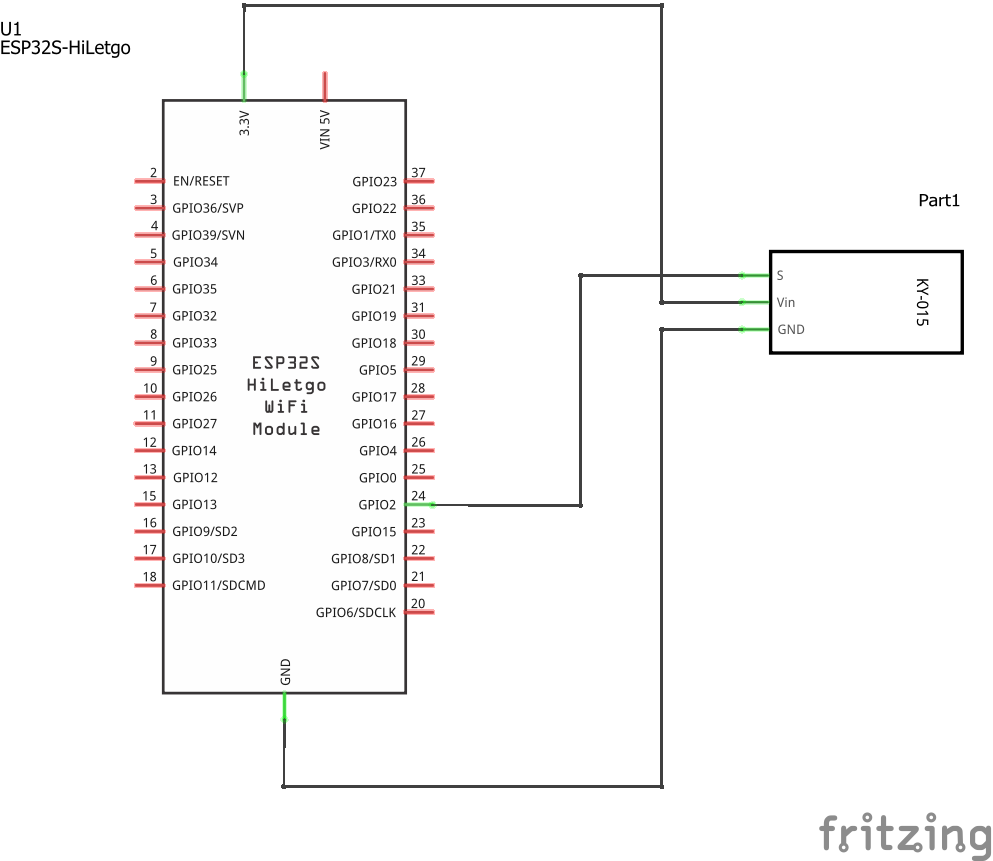Ejemplo 1 - Medición de temperatura y humedad usando el ESP32
Resumen
Realizar una aplicación que imprima la tempetatura y la humedad obtenida con un sensor DHT11 e imprimir el valor usando el monitor serial.
Hardware
Componentes
La siguiente tabla muestra los componentes principales del circuito a montar:
| Componentes | Cantidad | Observaciones |
|---|---|---|
| ESP32 | 1 | |
| DHT11 Temperature and Humidity Module | 1 | Disponible en el kit Elegoo (datasheet) |
Es importante conocer los pines sensor. A continuación se muestra un mapa de estos (link):

En kid Elegoo tiene un modulo que usa este sensor. Este se muestra a continuación junto con la descripción de los pines de conexión:

Esquematico

Diagrama de conexión
La conexión entre el sensor DHT11 y el ESP32 se muestra en la siguiente tabla:
| ESP32 | DHT11 |
|---|---|
| P2 (GPIO2) | S |
| 3.3V (VIN3.3V) | VSS |
| GND (GND) | GND |
A continuación se muestra el diagrama de conexión:

Archivo Fritzing El archivo Fritzing dh11-esp32.fzz del ejemplo se puede descargar del siguiente [link]
Software
Este ejemplo se codifico y probo en el IDE de Arduino v1. A modo de repaso, intente replicar el procedimiento en el Platformio.
Configuración
Librerias empleadas
Como se menciono al principio, este ejemplo se probo usando el IDE de Arduino v1. Para llevar a cabo la instalación en la nueva versión del IDE de Arduino (Arduino v2) realice el mismo procedimiento siguiendo las indicaciones dadas en la pagina Installing libraries - Arduino v2 (link)
Se agregaron las siguientes librerias:
-
DHT

-
Adafruit Unified Sensor

Programa
El programa codificado (dth11_esp32.ino) se muestra a continuación:
#include "DHT.h"
#define DHTPIN 2 // Digital pin connected to the DHT sensor
// Feather HUZZAH ESP8266 note: use pins 3, 4, 5, 12, 13 or 14 --
// Pin 15 can work but DHT must be disconnected during program upload.
// Uncomment whatever type you're using!
#define DHTTYPE DHT11 // DHT 11
//#define DHTTYPE DHT22 // DHT 22 (AM2302), AM2321
//#define DHTTYPE DHT21 // DHT 21 (AM2301)
// Connect pin 1 (on the left) of the sensor to +5V
// NOTE: If using a board with 3.3V logic like an Arduino Due connect pin 1
// to 3.3V instead of 5V!
// Connect pin 2 of the sensor to whatever your DHTPIN is
// Connect pin 3 (on the right) of the sensor to GROUND (if your sensor has 3 pins)
// Connect pin 4 (on the right) of the sensor to GROUND and leave the pin 3 EMPTY (if your sensor has 4 pins)
// Connect a 10K resistor from pin 2 (data) to pin 1 (power) of the sensor
// Initialize DHT sensor.
// Note that older versions of this library took an optional third parameter to
// tweak the timings for faster processors. This parameter is no longer needed
// as the current DHT reading algorithm adjusts itself to work on faster procs.
DHT dht(DHTPIN, DHTTYPE);
void setup() {
Serial.begin(9600);
Serial.println(F("DHTxx test!"));
dht.begin();
}
void loop() {
// Wait a few seconds between measurements.
delay(2000);
// Reading temperature or humidity takes about 250 milliseconds!
// Sensor readings may also be up to 2 seconds 'old' (its a very slow sensor)
float h = dht.readHumidity();
// Read temperature as Celsius (the default)
float t = dht.readTemperature();
// Read temperature as Fahrenheit (isFahrenheit = true)
float f = dht.readTemperature(true);
// Check if any reads failed and exit early (to try again).
if (isnan(h) || isnan(t) || isnan(f)) {
Serial.println(F("Failed to read from DHT sensor!"));
return;
}
// Compute heat index in Fahrenheit (the default)
float hif = dht.computeHeatIndex(f, h);
// Compute heat index in Celsius (isFahreheit = false)
float hic = dht.computeHeatIndex(t, h, false);
Serial.print(F("Humidity: "));
Serial.print(h);
Serial.print(F("% Temperature: "));
Serial.print(t);
Serial.print(F("°C "));
Serial.print(f);
Serial.print(F("°F Heat index: "));
Serial.print(hic);
Serial.print(F("°C "));
Serial.print(hif);
Serial.println(F("°F"));
}
Test de la aplicación
Cuando se prueba la aplicación, la salida tiene la siguiente forma:

Otros recursos
Simulación online La simulación del programa descargado se encuentra en (link)
Referencias
- https://randomnerdtutorials.com/esp32-dht11-dht22-temperature-humidity-sensor-arduino-ide/
- https://randomnerdtutorials.com/esp32-dht11-dht22-temperature-humidity-web-server-arduino-ide/
- https://learn.sparkfun.com/tutorials/rht03-dht22-humidity-and-temperature-sensor-hookup-guide/all
- https://learn.adafruit.com/dht/overview
- https://programarfacil.com/blog/arduino-blog/sensor-dht11-temperatura-humedad-arduino/
- https://www.arduino.cc/reference/en/libraries/dht-sensor-library/
- https://wiki.seeedstudio.com/Grove-TemperatureAndHumidity_Sensor/
- https://www.seeedstudio.com/Grove-Temperature-Humidity-Sensor-DHT11.html
- https://www.seeedstudio.com/blog/2020/04/07/how-to-pick-the-best-temperature-and-humidity-sensor-for-your-arduino-project/
- https://www.seeedstudio.com/blog/2019/08/22/8-types-of-temperature-sensors-you-should-know/
- https://www.seeedstudio.com/blog/2022/11/11/selection-guide-of-grove-temperature-and-humidity-sensor-that-support-esphome/